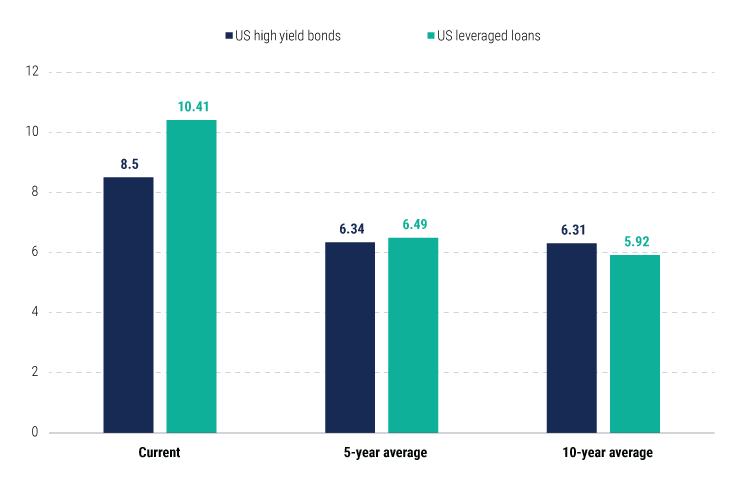Leveraged Loan Yields Hover Near 10-Year Highs, Offsetting Default Concerns

Kevin Wolfson
Portfolio Manager, US Leveraged Loans and CLO Management
Leveraged loan yields have reached levels not seen since 2009, at 10.78% in May and finishing June only slightly lower at 10.41%.1
Despite clouds forming on the horizon, we believe loan investors are poised to see good potential returns over the next six to 12 months.
While we expect default rates to increase and for recoveries to lag historical levels, the interest component of returns should help mitigate default-related losses.
With the Fed signaling that rate hikes are likely to continue after June’s pause, leveraged loans’ short-duration, floating-rate structure will continue to benefit investors, and we believe loans retain a slight edge over high yield bonds.

The leveraged loan market is starting from a position of strength after more than two years of strong corporate earnings, though fundamentals have begun to deteriorate amid persistently high interest rates. While defaults are a concern, we believe they will ultimately prove manageable and peak at 3%-4%, slightly above historical averages, and that any related losses will be modest. Behind our relative optimism is the small portion of lower-rated credits maturing in the next 18 months, along with strong yields and high coupons, which should help mitigate default-related losses.
That said, downgrades have substantially outpaced upgrades in recent months, and default rates are ticking up, reaching a two-year high in June. This comes as companies’ cash flows have come under pressure amid elevated interest rates and slower earnings growth, with issuers facing difficult comps in the second half of 2023. However, we’re seeing some easing of cost pressures that should help mitigate any slowing in issuers’ topline revenues.
Overall, we believe leveraged loans will continue to offer attractive risk-adjusted return potential over the next year and remain a critical component of investors’ fixed income allocations.
Maturities and liquidity look manageable overall, allaying concerns about a spike in defaults
Trailing-12-month (TTM) defaults reached a two-year high of 1.71% for the Morningstar LSTA US Leveraged Loan Index in June,2 and despite the likelihood for further increases, we believe defaults over the next year will stay within the vicinity of the 3% long-term average. Defaults are typically driven by either 1) an inability to address a debt maturity, or 2) a lack of liquidity. Although both will likely push defaults up in the near term, we don’t believe levels will come anywhere near the all-time highs witnessed in 2009 during the global financial crisis.
We see a couple of reasons for this. With regard to maturities, only about 2.6% of the loan market matures by the end of 2024 and the figure drops to 2.2% when excluding loans rated B+ and above.3 This matters because historically, a much higher percentage of defaults come from credits rated flat B and below than from their higher-rated counterparts.4
The other source of defaults has tended to be a lack of liquidity – i.e., when the issuer runs out of cash, revolver capacity, or asset-backed loan (ABL) capacity. Although fixed-charge coverage ratios, which offer a good view of companies’ ability to meet their financial obligations via earnings, are coming down as interest rates rise and EBITDA growth slows, ratios are still above 1.5x – the level where meeting these obligations starts to become a concern. Furthermore, we are starting to see issuers cut back on capex spending, a temporary move that may improve liquidity and partially offset the impact of higher interest rates.
Balanced supply and demand underscore benign technicals
We expect technicals to remain relatively benign in the second half of 2023 given the combination of a slowdown in demand for loans and the lack of new-issue loan supply.
Collateralized loan obligation (CLO) liability spreads have remained unchanged in recent months as loan spreads have tightened, leading to a lack of new CLO formation – historically a large source of loan demand. Moreover, roughly 40% of existing US CLOs are expected to exit their reinvestment periods this year, thus shrinking another source of demand for loans.
While we could see some demand from retail investors if they believe rates will remain higher for longer, this would be marginal at most.
Offsetting the lack of demand for loans is the lack of new-issue supply. Mergers and acquisitions (M&A) and leveraged buyout (LBO) activity are among the largest sources of new loan supply under normal conditions, and with LBO financing costs high and a recession potentially looming, we expect the trend of minimal M&A/LBO activity to continue.
Excluding refinancings and maturity extensions, new-loan supply is at levels similarly low to what we were seeing in 2009. That said, we do expect the loan market to remain open to refinancings and maturity extensions, especially for higher-quality issuers.
What does all this mean for technicals? We expect the loan market to stay relatively balanced over the near term with supply and demand near equilibrium, limiting the impact on performance from technicals and therefore allowing fundamentals and coupon payments to play a greater role in driving returns.
Leveraged loans retain a slight edge over high yield bonds
Bank loans and CLOs have had a slight advantage over fixed-rate high yield bonds since the beginning of 2022, with the floating-rate nature of loans and CLOs providing protection against rising rates. Total yields are also materially higher, at 10.4% for loans compared with 8.5% for high yield (see chart).
Leveraged Loan Yields Are Near 10-Year Highs

Source: Bloomberg as of 30 June 2023. US high yield bonds: Bloomberg US Corporate High Yield Bond Index YTW. US Leveraged Loans: Morningstar US Leveraged Loan Index Yield-to-Maturity.
As in the leveraged loan markets, trailing-12-month defaults for US high yield bonds have risen, reaching 2.4% in June5 – well off the lows from a year ago but still below long-term historical averages.
At the same time, credit quality in the leveraged loan market has declined in recent years, while the opposite has been true for high yield bonds. Downgrade/upgrade ratios for the high yield market remained balanced in June, with rising stars making up for downgrades among struggling credits. In contrast, the rolling downgrade/upgrade ratio for leveraged loans remains elevated, ending June at 2.37x; moreover, the percentage of the loan market rated CCC+ or below increased to the highest level in almost two years, at 7.7%,6 and the percentage of single-B credits has also increased from roughly one-quarter of the leveraged loan market in 2000 to two-thirds of the market today. That said, we see little cause for immediate concern given the small portion of loans rated single-B or below maturing before year-end 2024.
All told, with the Fed signaling that further rate increases are likely, we believe the relative value proposition remains stronger for floating versus fixed-rate assets over the short term, but it is tilting closer to neutral.
Key investor takeaways
Leveraged loan valuations are attractive, with yields near the highest levels since 2009. At current levels of 10.4%,7 even if default rates were to rise to 4%, which is at the top end of what we expect, and recoveries came in at just 50% (below the long-term historical average), the impact on total returns would be mitigated by the high overall yields.
In order to offset the coupon payments investors should expect to receive in the next six to 12 months, loan prices would have to drop appreciably from the current weighted average price of $94.2,8 which would likely happen only with a deeper and more widespread recession than our base case is forecasting.
Moreover, looking over the history of the loan market, two key points stand out. First, during periods when the Fed has paused interest rate hikes, loans have returned 7.5% on average over the following 12 months.9 And second, in all nine of the instances between 2007 and 2022 when the average bid of the loan market was at or below 94 and then rose above that level, the loan market posted positive returns in the following 12 months. The average bid of the market crossed this threshold in June of this year.
Despite the recent rally, the weighted average price is still at a significant discount to par, and with greater volatility present in the market, we expect increased dispersion in security- and sector-level returns – an opportune environment for credit selectors. We are less constructive on certain cyclicals given the late stage of the credit cycle and are taking a selective approach within healthcare; the sector is one of the largest within the loan market and has been the leading source of defaults this year, both by initial amount outstanding and by loan count (at 29% and 17%, respectively).10 We continue to see healthy consumer spending and have a favorable view of the leisure and travel sectors in the near term.
Though fundamentals are weakening, the market is starting from a position of strength, and our base case is for a mild recession with default rates rising only slightly above the historical average. In that scenario, we expect base rates to remain elevated, offering investors compelling interest rate-driven return potential over the next six to 12 months.
For more market insights, read our 2023 Midyear Fixed Income Outlook.
Footnotes
1 Source: Morningstar as of 30 June 2023.
2 Source: Morningstar as of 30 June 2023.
3 Source: LCD/Pitchbook LLI Maturity Breakdown as of 23 June 2023 (data represents performing loans).
4 Source: Deutsche Bank Default Study, 31 May 2023
5 Source: BofA Global Research as of 30 June 2023.
6 Source: Morningstar data as of 31 June 2023.
7 Source: Morningstar data as of 30 June 2023.
8 Source: LCD/Pitchbook Daily Index Returns as of 30 June 2023.
9 Source: J.P. Morgan, U.S. High Yield & Leveraged Loan Credit Outlook, May 2023.
10 Source: LCD Loan Default List, 31 May 2023.
Disclosure
Investing involves risk, including possible loss of principal. The information presented herein is for illustrative purposes only and should not be considered reflective of any particular security, strategy, or investment product. It represents a general assessment of the markets at a specific time and is not a guarantee of future performance results or market movement. This material does not constitute investment, financial, legal, tax, or other advice; investment research or a product of any research department; an offer to sell, or the solicitation of an offer to purchase any security or interest in a fund; or a recommendation for any investment product or strategy. PineBridge Investments is not soliciting or recommending any action based on information in this document. Any opinions, projections, or forward-looking statements expressed herein are solely those of the author, may differ from the views or opinions expressed by other areas of PineBridge Investments, and are only for general informational purposes as of the date indicated. Views may be based on third-party data that has not been independently verified. PineBridge Investments does not approve of or endorse any republication of this material. You are solely responsible for deciding whether any investment product or strategy is appropriate for you based upon your investment goals, financial situation and tolerance for risk.



